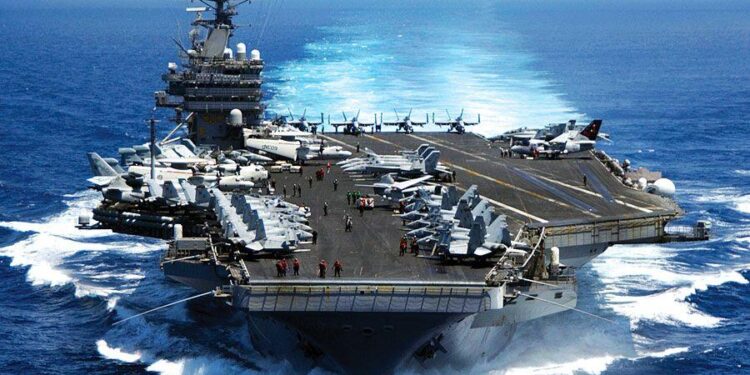Russia’s only aircraft carrier, the Admiral Kuznetsov, is facing an uncertain future, with shipbuilding authorities indicating that the vessel is likely to be scrapped or sold. This development marks a significant turning point for the Russian Navy, as the aging warship has long been a symbol of Moscow’s maritime ambitions. According to statements from the shipbuilding chief, the decision reflects the challenges of maintaining the vessel amid technological limitations and budgetary constraints, raising questions about the future of Russia’s naval aviation capabilities.
Russia Faces Strategic Shift as Sole Aircraft Carrier Faces Imminent Decommissioning
Russia’s naval capabilities are on the cusp of a significant transformation as the country’s only aircraft carrier, the Admiral Kuznetsov, approaches the end of its operational life. According to statements from the chief of the United Shipbuilding Corporation, the vessel is either headed for decommissioning and scrapping or possibly being sold to an undisclosed buyer. This development marks a pivotal moment for the Russian Navy, which for decades has relied heavily on the Kuznetsov to project power far beyond its borders. Maintenance challenges, frequent mechanical failures, and the enormous cost of refurbishment efforts have compounded to make keeping the carrier active increasingly untenable.
Key factors influencing the decision include:
- Age and mechanical reliability issues after decades of service
- Escalating costs of modernization versus building new vessels
- Shifting strategic priorities focusing on submarines and missile technology
- Possible international buyers interested in acquiring the platform
| Parameter | Details |
|---|---|
| Years in Service | Over 35 years |
| Displacement | Approx. 55,000 tons |
| Major Repairs | Multiple extended dry-docks |
| Estimated Decommissioning Year | 2024-2025 |
Experts Analyze Impact on Russian Naval Capabilities and Regional Power Projection
Defense analysts express concern that the potential scrapping or sale of Russia’s sole aircraft carrier could significantly diminish Moscow’s naval capabilities, undermining its ability to sustain blue-water operations. The carrier has long been a symbol of Russian maritime ambition, enabling power projection beyond coastal waters and serving as a strategic deterrent. Without it, Russia’s Navy may face challenges in maintaining a credible presence in contested regions such as the Mediterranean and the Arctic, potentially ceding influence to rival naval forces.
Key implications highlighted by experts include:
- Reduction in carrier-based air operations limits force projection flexibility
- Decreased capacity for sustained offshore combat missions
- Potential shift in Russian naval doctrine towards coastal defense and submarine warfare
- Impact on Russia’s ability to support allies in remote maritime theaters
| Capability | Pre-Carrier Status | Post-Carrier Status |
|---|---|---|
| Airborne Strike Reach | Extended beyond 1,000 km | Significantly reduced |
| Force Projection | Global maritime zones | Primarily regional coastal areas |
| Naval Deterrence | Enhanced by carrier presence | Weakened, reliant on submarines |
Recommendations for Fleet Modernization Amid Financial and Geopolitical Constraints
In light of acute financial pressures and the complex geopolitical landscape, adapting naval capabilities requires a strategic shift from traditional large-scale platforms to more versatile and cost-effective assets. Prioritizing the modernization of existing vessels with upgraded avionics, propulsion systems, and weapons technologies can extend service life without the prohibitive costs of new construction. Embracing modular designs and incorporating unmanned systems for reconnaissance and defense offer significant operational flexibility while minimizing crew requirements and maintenance overhead.
Decision-makers should focus on these key areas to optimize fleet readiness within current constraints:
- Investment in Multi-role Surface Combatants: Smaller, agile vessels capable of performing varied missions reduce dependence on singular large platforms.
- Integration of Advanced Electronic Warfare: Enhancing survivability and battlefield awareness against evolving threats.
- Collaboration with Allied Navies: Sharing technology and joint exercises to maximize interoperability and resource efficiency.
- Incremental Fleet Upgrades: Phased modernization programs tailored to budget cycles to avoid sudden capability gaps.
| Modernization Focus | Benefits | Estimated Cost Impact |
|---|---|---|
| Modular Systems | Rapid upgrades, mission adaptability | Moderate |
| Unmanned Vehicles | Force multiplication, risk reduction | Low to Moderate |
| Electronic Warfare Suites | Enhanced defense & situational awareness | High |
| Allied Collaboration | Resource sharing, interoperability | Low |
The Way Forward
As Russia faces increasing economic and strategic challenges, the future of its sole aircraft carrier remains uncertain. With the shipbuilding chief indicating plans to scrap or sell the vessel, the move signals a significant shift in Moscow’s naval ambitions. Observers will be closely monitoring how this decision impacts Russia’s maritime capabilities and regional influence in the years ahead.
















